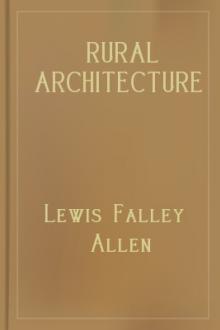Rural Architecture by Lewis Falley Allen (accelerated reader books .txt) 📖

- Author: Lewis Falley Allen
- Performer: -
Book online «Rural Architecture by Lewis Falley Allen (accelerated reader books .txt) 📖». Author Lewis Falley Allen


GROUND PLAN.
The front door from the veranda of the house opens into a hall, 18×8 feet, and 11 feet high, amply lighted by sash windows on the sides, and over the door. From the rear of this hall runs a flight of easy stairs, into the upper or chamber hall. On one side of the lower hall, a door leads into a parlor, 18 feet square, and 11 feet high, lighted by three windows, and warmed by an open stove, or fireplace, the pipe passing into a chimney flue in the rear. A door passes from this parlor into a rear passage, or entry, thus giving it access to the kitchen and rear apartments. At the back end of the front hall, a door leads into the rear passage and kitchen; and on the side opposite the parlor, a door opens into the sitting or family room, 18×16 feet in area, having an open fireplace, and three windows. On the hall side of this room, a door passes into the kitchen, 22×16 feet, and which may, in case the requirements of the family demand it, be made the chief family or living room, and the last one described converted into a library. In this kitchen, which is lighted by two windows, is a liberal open fireplace, with an ample oven by its side, and a sink in the outer corner. A flight of stairs, also, leads to the rear chambers above; and a corresponding flight, under them, to the cellar below. A door at each end of these stairs, leads into the back entry of the house, and thus to the other interior rooms, or through the rear outer door to the back porch. This back entry is lighted by a single sash window over the outside door leading to the porch. Another door, opposite that leading down cellar, opens into the passage through the wing. From the rear hall, which is 16×5 feet, the innermost passage leads into a family bedroom, or nursery, 16×14 feet, lighted by a window in each outside wall, and warmed by an open fireplace, or stove, at pleasure. Attached to this bedroom is a clothes-closet, 8×4 feet, with shelves, and drawers. Next the outer door, in rear end of the hall, is a small closet opening from it, 6×4 feet in dimensions, convertible to any use which the mistress of the house may direct.


CHAMBER PLAN.
Opening into the wing from the kitchen, first, is a large closet and pantry, supplied with a table, drawers, and shelves, in which are stored the dishes, table furniture, and edibles necessary to be kept at a moment's access. This room is 14×8 feet, and well lighted by a window of convenient size. If necessary, this room may have a partition, shutting off a part from the everyday uses which the family requires. In this room, so near to the kitchen, to the sink, to hot-water, and the other little domestic accessories which good housewives know so well how to arrange and appreciate, all the nice little table-comforts can be got up, and perfected, and stored away, under lock and key, in drawer, tub, or jar, at their discretion, and still their eyes not be away from their subordinates in the other departments. Next to this, and connected by a door, is the dairy, or milk-room, also 14×8 feet; which, if necessary, may be sunk three or four feet into the ground, for additional coolness in the summer season, and the floor reached by steps. In this are ample shelves for the milkpans, conveniences of churning, &c., &c. But, if the dairy be a prominent object of the farm, a separate establishment will be required, and the excavation may not be necessary for ordinary household uses. Out of this milk-room, a door leads into a wash-room, 18×14 feet. A passage from the kitchen also leads into this. The wash-room is lighted by two windows in rear, and one in front. A sink is between the two rear windows, with conductor leading outside, and a closet beneath it, for the iron ware. In the chimney, at the end, are boilers, and a fireplace, an oven, or anything else required, and a door leading to a platform in the wood-house, and so into the yard. On the other side of the chimney, a door leads into a bathing-room, 7×6 feet, into which hot water is drawn from one of the boilers adjoining, and cold water may be introduced, by a hand-pump, through a pipe leading into the well or cistern.
As no more convenient opportunity may present itself, a word or two will be suggested as to the location of the bath-room in a country house. In city houses, or country houses designed for the summer occupancy of city dwellers, the bathing-rooms are usually placed in the second or chamber story, and the water for their supply is drawn from cisterns still above them. This arrangement, in city houses, is made chiefly from the want of room on the ground floor; and, also, thus arranged in the city-country houses, because they are so constructed in the city. In the farm house, or in the country house proper, occupied by whom it may be, such arrangement is unnecessary, expensive, and inconvenient. Unnecessary, because there is no want of room on the ground; expensive, because an upper cistern is always liable to leakages, and a consequent wastage of water, wetting, and rotting out the floors, and all the slopping and dripping which such accidents occasion; and inconvenient, from the continual up-and-down-stair labor of those who occupy the bath, to say nothing of the piercing the walls of the house, for the admission of pipes to lead in and let out the water, and the thousand-and-one vexations, by way of plumbers' bills, and expense of getting to and from the house itself, always a distance of some miles from the mechanic.
The only defence for such location of the bath-room and cisterns is, the convenience and privacy of access to them, by the females of the family. This counts but little, if anything, over the place appropriated in this, and the succeeding designs of this work. The access is almost, if not quite as private as the other, and, in case of ill-health, as easily approachable to invalids. And on the score of economy in construction, repair, or accident, the plan here adopted is altogether preferable. In this plan, the water is drawn from the boiler by the turning of a cock; that from the cistern, by a minute's labor with the hand-pump. It is let off by the drawing of a plug, and discharges, by a short pipe, into the adjoining garden, or grassplat, to moisten and invigorate the trees and plants which require it, and the whole affair is clean and sweet again. A screen for the window gives all the privacy required, and the most fastidious, shrinking female is as retired as in the shadiest nook of her dressing-room.
So with water-closets. A fashion prevails of thrusting these noisome things into the midst of sleeping chambers and living rooms—pandering to effeminacy, and, at times, surcharging the house—for they cannot, at all times, and under all circumstances, be kept perfectly close—with their offensive odor. Out of the house they belong; and if they, by any means, find their way within its walls proper, the fault will not be laid at our door.
To get back to our description. This bathing-room occupies a corner of the wood-house.
A raised platform passes from the wash-room in, past the bath-room, to a water-closet, which may be divided into two apartments, if desirable. The vaults are accessible from the rear, for cleaning out, or introducing lime, gypsum, powdered charcoal, or other deodorizing material. At the extreme corner of the wood-house, a door opens into a feed and swill-room, 20×8 feet, which is reached by steps, and stands quite eighteen inches above the ground level, on a stone under-pinning, or with a stone cellar beneath, for the storage of roots in winter. In one corner of this is a boiler and chimney, for cooking food for the pigs and chickens. A door leads from this room into the piggery, 20×12 feet, where half-a-dozen swine may be kept. A door leads from this pen into a yard, in the rear, where they will be less offensive than if confined within. If necessary, a flight of steps, leading to the loft overhead, may be built, where corn can be stored for their feeding.
Next to this is the workshop and tool-house, 18×14 feet; and, in rear, a snug, warm house for the family chickens, 18×6 feet. These chickens may also have the run of the yard in rear, with the pigs, and apartments in the loft overhead for roosting.
Adjoining the workshop is the carriage house, 18×18 feet, with a flight of stairs to the hayloft above, in which is, also, a dovecote; and, leading out of the carriage floor, is the stable, 18×12 feet, with stalls for two or four horses, and a passage of four feet wide, from the carriage-house into it; thus completing, and drawing under one continuous roof, and at less exposure than if separated, the chief every-day requirements of living, to a well-arranged and highly-respectable family.
The chamber plan of the dwelling will be readily understood by reference to its arrangement. There are a sufficiency of closets for all purposes, and the whole are accessible from either flight of stairs. The rooms over the wing, of course, should be devoted to the male domestics of the family, work-people, &c.
SURROUNDING PLANTATIONS, SHRUBBERY, WALKS, ETC.After the general remarks made in the preceding pages, no particular instructions can be given for the manner in which this residence should be embellished in its trees and shrubbery. The large forest trees, always grand, graceful, and appropriate, would become such a house, throwing a protecting air around and over its quiet, unpretending roof. Vines, or climbing roses, might throw their delicate spray around the columns of the modest veranda, and a varied selection of familiar shrubbery and ornamental plants checker the immediate front and sides of the house looking out upon the lawn; through which a spacious walk, or carriage-way should wind, from the high road, or chief approach.
There are, however, so many objects to be consulted in the various sites of houses, that no one rule can be laid down for individual guidance. The surface of the ground immediately adjoining the house must be considered; the position of the house, as it is viewed from surrounding objects; its altitude, or depression, as affected by the adjacent lands; its command upon surrounding near, or distant objects, in the way of prospect; the presence of water, either in stream, pond, or lake, far or near, or the absence of water altogether—all these enter immediately into the manner in which the lawn of a house should be laid out, and worked, and planted. But as a rule, all filagree work, such as serpentine paths, and tortuous, unmeaning circles, artificial piles of rock, and a multitude of small ornaments—so esteemed, by some—should never be introduced into the lawn of a farm house. It is unmeaning, in the first place; expensive in its care, in the second place; unsatisfactory and annoying altogether. Such things about a farm establishment are neither dignified nor useful,





Comments (0)